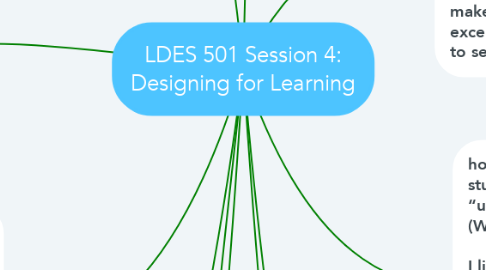LDES 501 Session 4: Designing for Learning
by Yianna Vovides

1. what is the difference between instructional design and learning design? From your experience as learners, which method/ terminology are you most drawn too? Why?
2. what real-world examples of evidence might this look like in the classroom or training program setting? As learning designers, how do we apply backward design for students not only to remember, but to ask what, so why, and how questions when learning new material?
3. Also, what does the book mean by “think like an assessor”; what is an assessor in this context as a learning designer? (Wiggins, 2005) As learning designers, how do we get that desired result from students? How do we not choose to own our understanding of what students should know, comprehend, and be able to do?
4. First, do the learning models evolve as ideas about learning evolve? I noticed that the article was written in 1994 and though about how Siemens's idea of connectivism and a more networked approach to learning might shape some of the models in the article. Second, while I definitely recognize the need for models and formulas to improve instructional design, I wondered whether we can ever fully engineer learning outcomes with models.
4.1. It would be interesting to do a hermeneutic meta-analysis of similar studies of work environments because it reminded me of my work in assessment. In this environment, it is 100% informal learning and you better ask a lot of questions in the first 6 months or you’ll find yourself getting laughed at by a mid-level manager who is probably more stressed than you. For my own curiosity, how does Georgetown University’s instructional design work compare to the experiences in this study? If it’s similar, why?
5. In the books we have read so far, we’ve learned that mistakes are the result of scientific students misunderstanding wrong data. However, if an exam determines the job performance of a teacher, or a student’s entry into college would it not place a pressure on the educator to increase the likelihood of scoring well on an exam, and a less focus on mistakes?
6. What would it mean to create learning and work environments that allow for generative learning without shame? On a similar note, what would it mean to instill a sense of belonging in learning and work environments? Could this allow for generative learning without shame?
7. Does this exposure to design concepts significantly alter recent understandings/readings/conclusions? Do these revelations of the role that design plays reveal deeper challenges at-play in Love, McQuire, and Roedgier discussion?
8. How do we understand the differing responsibilities of teaching and designing? Is it useful/possible to compare the value in each as it relates to learning outcomes, achievement, “success”? Can designers (who are not teachers or experts) fall short if they don’t fully grasp the material? Can an educator make-up for subpar design with excellent teaching? Are they easy to separate?
9. how can teachers make sure students are on the same goal in “understanding” new material? (Wiggins, 2005) I like how the author explains two concepts “knowledge” and “understanding”; and what it might look like in education and teaching. Do you think that “understanding” is an extension of a story (i.e., why, what, and how)? (Wiggins, 2005)
9.1. Is instructional design a professional field where you continuously must learn new material for a training program? When is appropriate or inappropriate to design new learning strategies for training programs? (Edmonds, 1994)
9.2. what if a prospective ID does not have the same prior design training as an “experienced” ID? (Edmonds, 1994) Also, is the prospective ID trained by another institution or is there another professional that can be in the position to teach instructional design?
9.3. Is it possible if instructional designers can “master” instructional design depending on how much experience they have in the profession? If not, then why can’t instructional design be “mastered”? (Edmonds, 1994)
10. Will there ever be a way for us to design for all forms of learning (formal, nonformal, and informal), or will there be always be a kind of learning that happens that cannot be anticipated?
11. How can we universally test students with this method in an efficient and standardized way?


